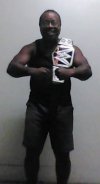When working out on Sundays, Tuesdays and Thursdays I like to put a spin to my wrestling training using Kettlebells with resistance bands.
Strength Curves
Strength Movements are divided into three groups...
1) Descending Strength Curve
Exercise that are easy at the beginning and hard at the end have a Descending Strength Curve.
Example
a) Bent Over Rows
b) Lat Pulldowns
2) Bell Shaped Strength Curve
Exercise that are easy at the start, hard in the middle and easy at the end of the movement have a Bell Shaped Curve.
Examples
a) Triceps Pushdowns
b) Bicep Curls
3) Ascending Strength Curve
Exercise that are hard in the bottom part of the movement and get easier toward the top have an Ascending Strength Curve.
Examples
a) Squats
b) Pressing Movements
c) Deadlifts
Dr Ariel Gideon's Research
Gideon's research (published in 1973) determined that approximately one-third of and exercise overloads the muscle with approximately two-thirds of it being underloaded. Thus, only around one-third of an exercise optimally work the muscles a movement
Accommodation Resistance
Attaching Band and/or Chain to a Ascending Strength Curve Exercise ensures that the muscles in a movement are optimall worked though a greater range of the movement.
Kettlebell Swings
The Kettlebell Swing is a Descending Strength Curve Movement.
It is also a Power Movement. Research (Dr Bret Contreras) demonstrated that Power Output with a Heavy Kettlebell Swing rivals Olympic Movements.
The Issue With Kettlebells Swing
Many individuals perform Swings with a Kettlebell that is too light.
At some point in a light Swing, lifters allow the Bell to float. No force is being applied; Power is not developed in that part of the Swing when the Bell is allowed to float.
To ensure Power Output is fully developed in a Kettlebell Swing one of the following two options are...
1) Heavy Kettlebell Swings
Perform the Swings with a Kettlebell Weight that is between one-third to close to and individual body weight.
150 Lifter Example
That means a lifter who weighed 150 lb would need to perform a Kettlebell Swing with 50 to near 150 lbs to optimally train and devevelop Power.
2) Banded Kettlebell Swings
The Band Kettlebell Resistance ensure a lifter develops Force Production through a greater Range of the Movement
Take Home Message
If Power Output Development is the objective of the Kettlebell Swing, one of the two approaches above need to be implemented.

